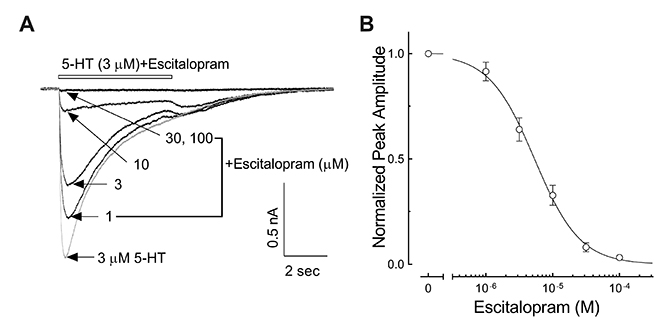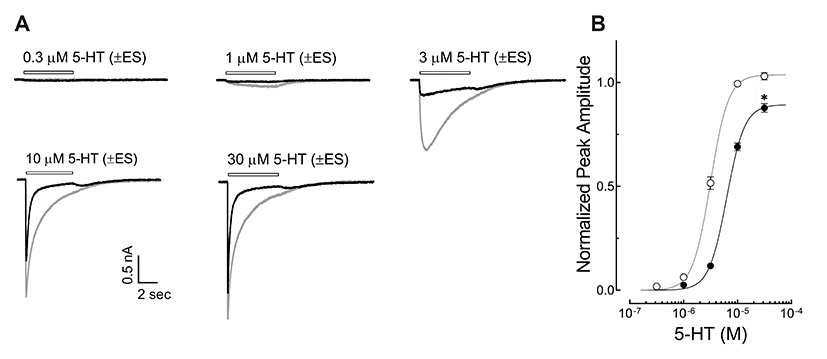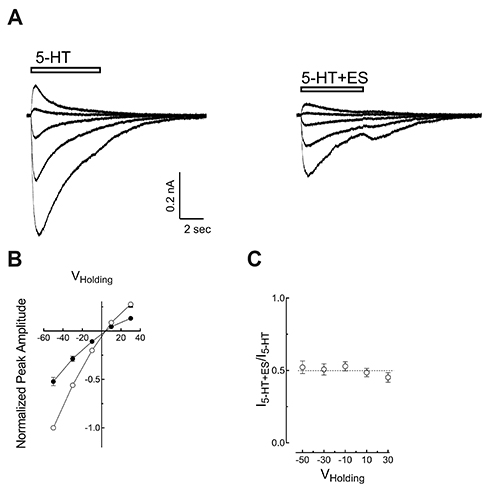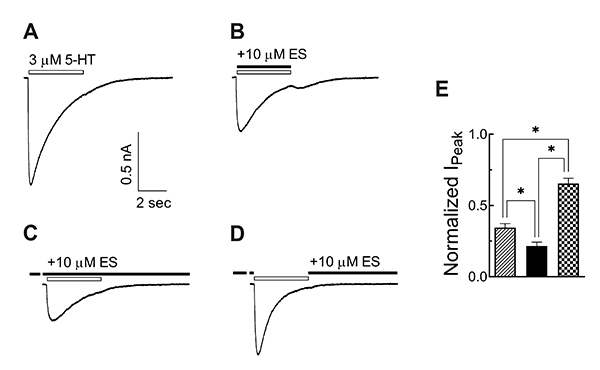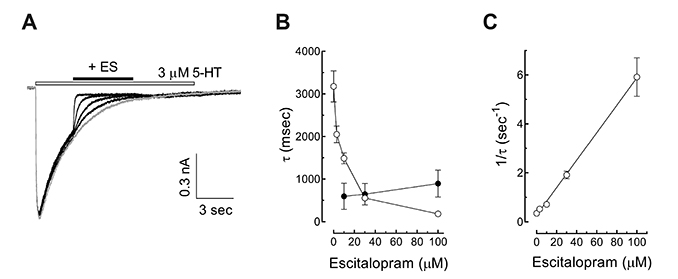Korean J Physiol Pharmacol.
2019 Nov;23(6):509-517. 10.4196/kjpp.2019.23.6.509.
Selective serotonin reuptake inhibitor escitalopram inhibits 5-HT₃ receptor currents in NCB-20 cells
- Affiliations
-
- 1Department of Anatomy, College of Medicine, The Catholic University of Korea, Seoul 06591, Korea.
- 2Department of Pharmacology, College of Medicine, The Catholic University of Korea, Seoul 06591, Korea. sungkw@catholic.ac.kr
- KMID: 2461044
- DOI: http://doi.org/10.4196/kjpp.2019.23.6.509
Abstract
- Escitalopram is one of selective serotonin reuptake inhibitor antidepressants. As an S-enantiomer of citalopram, it shows better therapeutic outcome in depression and anxiety disorder treatment because it has higher selectivity for serotonin reuptake transporter than citalopram. The objective of this study was to determine the direct inhibitory effect of escitalopram on 5-hydroxytryptamine type 3 (5-HT₃) receptor currents and study its blocking mechanism to explore additional pharmacological effects of escitalopram through 5-HT₃ receptors. Using a whole-cell voltage clamp method, we recorded currents of 5-HT₃ receptors when 5-HT was applied alone or co-applied with escitalopram in cultured NCB-20 neuroblastoma cells known to express 5-HT₃ receptors. 5-HT induced currents were inhibited by escitalopram in a concentration-dependent manner. EC50 of 5-HT on 5-HT₃ receptor currents was increased by escitalopram while the maximal peak amplitude was reduced by escitalopram. The inhibitory effect of escitalopram was voltage independent. Escitalopram worked more effectively when it was co-applied with 5-HT than pre-application of escitalopram. Moreover, escitalopram showed fast association and dissociation to the open state of 5-HT₃ receptor channel with accelerating receptor desensitization. Although escitalopram accelerated 5-HT₃ receptor desensitization, it did not change the time course of desensitization recovery. These results suggest that escitalopram can inhibit 5-HT₃ receptor currents in a non-competitive manner with the mechanism of open channel blocking.
Keyword
MeSH Terms
Figure
Reference
-
1. Hyttel J. Citalopram--pharmacological profile of a specific serotonin uptake inhibitor with antidepressant activity. Prog Neuropsychopharmacol Biol Psychiatry. 1982; 6:277–295.2. Waugh J, Goa KL. Escitalopram : a review of its use in the management of major depressive and anxiety disorders. CNS Drugs. 2003; 17:343–362.3. Bræstrup C, Sanchez C. Escitalopram: a unique mechanism of action. Int J Psychiatry Clin Pract. 2004; 8 Suppl 1:11–13.
Article4. Thaler K, Delivuk M, Chapman A, Gaynes BN, Kaminski A, Gartlehner G. Second-generation antidepressants for seasonal affective disorder. Cochrane Database Syst Rev. 2011; (12):CD008591.
Article5. Patetsos E, Horjales-Araujo E. Treating chronic pain with SSRIs: what do we know? Pain Res Manag. 2016; 2016:2020915.
Article6. Howland RH. A question about the potential cardiac toxicity of escitalopram. J Psychosoc Nurs Ment Health Serv. 2012; 50:17–20.
Article7. Garfield LD, Dixon D, Nowotny P, Lotrich FE, Pollock BG, Kristjansson SD, Doré PM, Lenze EJ. Common selective serotonin reuptake inhibitor side effects in older adults associated with genetic polymorphisms in the serotonin transporter and receptors: data from a randomized controlled trial. Am J Geriatr Psychiatry. 2014; 22:971–979.
Article8. Björkholm C, Marcus MM, Konradsson-Geuken Å, Jardemark K, Svensson TH. The novel antipsychotic drug brexpiprazole, alone and in combination with escitalopram, facilitates prefrontal glutamatergic transmission via a dopamine D1 receptor-dependent mechanism. Eur Neuropsychopharmacol. 2017; 27:411–417.
Article9. Thériault O, Poulin H, Beaulieu JM, Chahine M. Differential modulation of Nav1.7 and Nav1.8 channels by antidepressant drugs. Eur J Pharmacol. 2015; 764:395–403.
Article10. Chae YJ, Jeon JH, Lee HJ, Kim IB, Choi JS, Sung KW, Hahn SJ. Escitalopram block of hERG potassium channels. Naunyn Schmiedebergs Arch Pharmacol. 2014; 387:23–32.
Article11. Sugita S, Shen KZ, North RA. 5-hydroxytryptamine is a fast excitatory transmitter at 5-HT3 receptors in rat amygdala. Neuron. 1992; 8:199–203.12. Katsurabayashi S, Kubota H, Tokutomi N, Akaike N. A distinct distribution of functional presynaptic 5-HT receptor subtypes on GABAergic nerve terminals projecting to single hippocampal CA1 pyramidal neurons. Neuropharmacology. 2003; 44:1022–1030.
Article13. Thompson AJ, Lummis SC. 5-HT3 receptors. Curr Pharm Des. 2006; 12:3615–3630.14. Barnes NM, Hales TG, Lummis SC, Peters JA. The 5-HT3 receptor--the relationship between structure and function. Neuropharmacology. 2009; 56:273–284.15. Maricq AV, Peterson AS, Brake AJ, Myers RM, Julius D. Primary structure and functional expression of the 5HT3 receptor, a serotonin-gated ion channel. Science. 1991; 254:432–437.16. Thompson AJ, Lummis SC. The 5-HT3 receptor as a therapeutic target. Expert Opin Ther Targets. 2007; 11:527–540.17. Walstab J, Rappold G, Niesler B. 5-HT3 receptors: role in disease and target of drugs. Pharmacol Ther. 2010; 128:146–169.18. Navari RM. 5-HT3 receptors as important mediators of nausea and vomiting due to chemotherapy. Biochim Biophys Acta. 2015; 1848(10 Pt B):2738–2746.19. Smith HS, Cox LR, Smith EJ. 5-HT3 receptor antagonists for the treatment of nausea/vomiting. Ann Palliat Med. 2012; 1:115–120.20. Gupta D, Radhakrishnan M, Kurhe Y. Ondansetron, a 5HT3 receptor antagonist reverses depression and anxiety-like behavior in streptozotocin-induced diabetic mice: possible implication of serotonergic system. Eur J Pharmacol. 2014; 744:59–66.21. Nasirinezhad F, Hosseini M, Karami Z, Yousefifard M, Janzadeh A. Spinal 5-HT3 receptor mediates nociceptive effect on central neuropathic pain; possible therapeutic role for tropisetron. J Spinal Cord Med. 2016; 39:212–219.22. Engleman EA, Rodd ZA, Bell RL, Murphy JM. The role of 5-HT3 receptors in drug abuse and as a target for pharmacotherapy. CNS Neurol Disord Drug Targets. 2008; 7:454–467.23. Lovinger DM, White G. Ethanol potentiation of 5-hydroxytryptamine3 receptor-mediated ion current in neuroblastoma cells and isolated adult mammalian neurons. Mol Pharmacol. 1991; 40:263–270.24. Rajkumar R, Mahesh R. The auspicious role of the 5-HT3 receptor in depression: a probable neuronal target? J Psychopharmacol. 2010; 24:455–469.25. Fan P. Inhibition of a 5-HT3 receptor-mediated current by the selective serotonin uptake inhibitor, fluoxetine. Neurosci Lett. 1994; 173:210–212.26. Eisensamer B, Rammes G, Gimpl G, Shapa M, Ferrari U, Hapfelmeier G, Bondy B, Parsons C, Gilling K, Zieglgänsberger W, Holsboer F, Rupprecht R. Antidepressants are functional antagonists at the serotonin type 3 (5-HT3) receptor. Mol Psychiatry. 2003; 8:994–1007.27. Choi JS, Choi BH, Ahn HS, Kim MJ, Rhie DJ, Yoon SH, Min DS, Jo YH, Kim MS, Sung KW, Hahn SJ. Mechanism of block by fluoxetine of 5-hydroxytryptamine3 (5-HT3)-mediated currents in NCB-20 neuroblastoma cells. Biochem Pharmacol. 2003; 66:2125–2132.28. Lambert JJ, Peters JA, Hales TG, Dempster J. The properties of 5-HT3 receptors in clonal cell lines studied by patch-clamp techniques. Br J Pharmacol. 1989; 97:27–40.29. Lovinger DM, Sung KW, Zhou Q. Ethanol and trichloroethanol alter gating of 5-HT3 receptor-channels in NCB-20 neuroblastoma cells. Neuropharmacology. 2000; 39:561–570.30. Kim KJ, Jeun SH, Sung KW. Lamotrigine, an antiepileptic drug, inhibits 5-HT3 receptor currents in NCB-20 neuroblastoma cells. Korean J Physiol Pharmacol. 2017; 21:169–177.31. Park YS, Sung KW. Gastrokinetic agent, mosapride inhibits 5-HT3 receptor currents in NCB-20 cells. Korean J Physiol Pharmacol. 2019; 23:419–426.32. Snyders DJ, Hondeghem LM, Bennett PB. Mechanisms of drug-channel interaction. In : Fozzard HA, Haber E, Jennings RB, Katz AM, Morgan HE, editors. The heart and cardiovascular system: scientific foundations. New York: Raven Press;1991. p. 2165–2193.33. Park YS, Myeong SH, Kim IB, Sung KW. Tricyclic antidepressant amitriptyline inhibits 5-hydroxytryptamine 3 receptor currents in NCB-20 cells. Korean J Physiol Pharmacol. 2018; 22:585–595.
Article34. Föhr KJ, Zeller K, Georgieff M, Köster S, Adolph O. Open channel block of NMDA receptors by diphenhydramine. Neuropharmacology. 2015; 99:459–470.
Article35. Johnson JW, Kotermanski SE. Mechanism of action of memantine. Curr Opin Pharmacol. 2006; 6:61–67.
Article36. Wang DS, Mangin JM, Moonen G, Rigo JM, Legendre P. Mechanisms for picrotoxin block of alpha2 homomeric glycine receptors. J Biol Chem. 2006; 281:3841–3855.37. Gunthorpe MJ, Lummis SC. Diltiazem causes open channel block of recombinant 5-HT3 receptors. J Physiol. 1999; 519 Pt 3:713–722.38. Kasper S, Spadone C, Verpillat P, Angst J. Onset of action of escitalopram compared with other antidepressants: results of a pooled analysis. Int Clin Psychopharmacol. 2006; 21:105–110.
Article39. Thompson AJ, Sullivan NL, Lummis SC. Characterization of 5-HT3 receptor mutations identified in schizophrenic patients. J Mol Neurosci. 2006; 30:273–281.
Article40. Nayak SV, Rondé P, Spier AD, Lummis SC, Nichols RA. Calcium changes induced by presynaptic 5-hydroxytryptamine-3 serotonin receptors on isolated terminals from various regions of the rat brain. Neuroscience. 1999; 91:107–117.
Article41. Haggarty SJ, Perlis RH. Pharmacology of serotonergic and central adrenergic neurotransmission. In : Golan DE, editor. Principles of pharmacology: the pathophysiologic basis of drug therapy. 4th ed. Philadelphia: Wolters Kluwer;2017. p. 227–248.
- Full Text Links
- Actions
-
Cited
- CITED
-
- Close
- Share
- Similar articles
-
- Lamotrigine, an antiepileptic drug, inhibits 5-HT₃ receptor currents in NCB-20 neuroblastoma cells
- Gastroprokinetic agent, mosapride inhibits 5-HT₃ receptor currents in NCB-20 cells
- Tricyclic antidepressant amitriptyline inhibits 5-hydroxytryptamine 3 receptor currents in NCB-20 cells
- Escitalopram, a selective serotonin reuptake inhibitor, inhibits voltage-dependent Kâ» channels in coronary arterial smooth muscle cells
- Serum Prolactin Levels in Patients with Major Depressive Disorder Receiving Selective Serotonin-Reuptake Inhibitor Monotherapy for 3 Months: A Prospective Study

